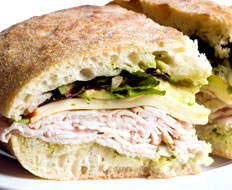In 2015, the single most popular dish on quick-serve restaurant menus will be a sumptuous curried goat sandwich served with fried lentils and a crispy tamarind-orange flatbread.
Shortly thereafter, thick, frosty duck confit milkshakes and turnip tots will take the fast food world by storm.
Then, by 2017, drive-thru windows will be overwhelmed by customers determined to get their hands on the latest menu sensation: big, brimming bowls of real Spanish-style paella, replete with fresh mussels and clams and saffron-infused rice.
The foregoing statements, I should point out quickly, are not the ravings of a lunatic, but an earnest attempt to demonstrate the perils of trying to forecast what Americans will be eating two, five, or 10 years down the road. Needless to say, none of them stands a prayer of showing up anywhere. (A duck confit milkshake isn’t even an actual thing.)
Who among us, after all, would have foreseen in the early ’90s the advent of grilled chicken sandwiches served on something called ciabatta bread—an Italian import that first caught on at some of the country’s finest restaurants? Who would have guessed that chipotle and pesto sauces, Angus steak, or aioli would be as commonplace in some parts as ketchup, mustard, and pickles? And it’s worth noting that not long ago, the idea of going to a quick-service establishment to snare a Caesar salad made with real romaine lettuce would have seemed utterly otherworldly.
It’s for this reason that aspiring menu-trend soothsayers need a system—a good one. Mine is something we at the Center for Culinary Development refer to as Trend Mapping, and it’s a methodology that’s worked quite well for us for more than a decade now. This content-analysis process posits that fine-dining chefs are extraordinarily good predictors of which new culinary ideas will ultimately make their way to the aisles of mainstream grocery stores and your menus.
Trend Mapping traces the development of culinary trends through a five-stage process that originates with creative chefs’ daily specials. Every day, all around the world, chefs trot out new recipes—road testing their experiments with customers and gauging reactions. Specials that gain traction tend to get promoted to the regular menu, where they eventually attract the attention of both food critics, who laud the dishes in published reviews, and competitors, who steal … er, borrow and build upon them.
Over time, the best ideas bubble up to the pages of gourmet magazines such as Bon Appétit or Food & Wine in what we refer to as Stage 2 of the Trend Mapping trajectory. It’s at this point that menu developers from casual-dining restaurant chains latch on and add the offering to their menus. We classify menu phenomena that get as far as a Chili’s or an Applebee’s as Stage 3 trends.
Shortly after a novel dish hits the menu at a major chain, you’ll typically see mainstream publications and women’s magazines feature it in their pages during Stage 4. And finally, there’s Stage 5: mass penetration, in which an ingredient or dish is “mainstreamed” and becomes available in grocery stores, at fast food chains, and among other far-reaching settings.
Some trends are simply too esoteric, expensive, or downright weird to migrate from Stage 1 to 5. In-house butchering is increasingly chic among the world’s big-name chefs, but I’m hard-pressed to imagine the manager of a local Steak ’n Shake carving up a cow carcass. Likewise, while many chefs are touting vegetables as the new meat and going to great lengths to promote dishes that contain less animal protein, I can’t envision Wendy’s or Carl’s Jr. tripping over themselves to promote a vegetarian hamburger topped with foraged purslane.
So with all that standing between Stages 1 and 5, you’re probably wondering what trends actually survive. Well, the most notable recent ones are breads, coffee, and gastropubs.
The first major installment in the better-bread saga took place in the early 2000s, when artisan-style breads such as ciabatta began appearing on quick-serve menus. Today the offerings at the fine-dining level are more interesting and imaginative than ever, but they’re also highly accessible and suitable for fast food settings. There’s pretzel bread, brioche, vegetable and sweet potato breads, popovers … the list goes on.
The trend in coffee is a move to better, more distinctive beans. I know what you’re thinking: Premium coffees of varying provenances in a quick-serve environment? Bet on it. Just as cappuccino machines have invaded your local McDonald’s, it may one day not be so strange to see a chain in your neighborhood offering five, 10, or a dozen beans, grinds, or brews. Consumers are ever more finicky about their joe nowadays, and more interested in its origins. Chains are likely to respond accordingly in time.
Speaking of beverages, there’s also a new take on the British drinking staple: the pub. In the past few years, many of the country’s top chefs have unveiled their gourmet takes on the U.K.’s public house. They’ve proved that such traditionally humble comfort foods as shepherd’s pie, chips and gravy, French onion soup, and blood sausage can be given an upscale treatment alongside more typical American bar fare like burgers, club sandwiches, and onion rings. It would surprise me not a whit to see some of the more accessible options turn up on fast food menus in coming years as more Americans get acquainted with these so-called gastropubs.
Which emerging food trends are going mainstream in your area? I’d be curious to know, and to mention them in this space sometime soon.

